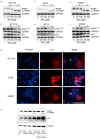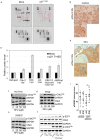Cytoplasmic p21 Mediates 5-Fluorouracil Resistance by Inhibiting Pro-Apoptotic Chk2
- PMID: 30304835
- PMCID: PMC6210175
- DOI: 10.3390/cancers10100373
Cytoplasmic p21 Mediates 5-Fluorouracil Resistance by Inhibiting Pro-Apoptotic Chk2
Abstract
The oncogenic cytoplasmic p21 contributes to cancer aggressiveness and chemotherapeutic failure. However, the molecular mechanisms remain obscure. Here, we show for the first time that cytoplasmic p21 mediates 5-Fluorouracil (5FU) resistance by shuttling p-Chk2 out of the nucleus to protect the tumor cells from its pro-apoptotic functions. We observed that cytoplasmic p21 levels were up-regulated in 5FU-resistant colorectal cancer cells in vitro and the in vivo Chorioallantoic membrane (CAM) model. Kinase array analysis revealed that p-Chk2 is a key target of cytoplasmic p21. Importantly, cytoplasmic form of p21 mediated by p21T145D transfection diminished p-Chk2-mediated activation of E2F1 and apoptosis induction. Co-immunoprecipitation, immunofluorescence, and proximity ligation assay showed that p21 forms a complex with p-Chk2 under 5FU exposure. Using in silico computer modeling, we suggest that the p21/p-Chk2 interaction hindered the nuclear localization signal of p-Chk2, and therefore, the complex is exported out of the nucleus. These findings unravel a novel mechanism regarding an oncogenic role of p21 in regulation of resistance to 5FU-based chemotherapy. We suggest a possible value of cytoplasmic p21 as a prognosis marker and a therapeutic target in colorectal cancer patients.
Keywords: 5-fluorouracil resistance; Chk2; colorectal cancer; cytoplasmic p21; p21; protein interaction.
Conflict of interest statement
The authors declare no conflicts of interest.
Figures









Similar articles
-
Tumor suppressor protein kinase Chk2 is a mediator of anoikis of intestinal epithelial cells.Int J Cancer. 2012 Jul 15;131(2):357-66. doi: 10.1002/ijc.26368. Epub 2011 Nov 2. Int J Cancer. 2012. PMID: 21834075
-
Casein Kinase 2α Enhances 5-Fluorouracil Resistance in Colorectal Cancer Cells by Inhibiting Endoplasmic Reticulum Stress.Anticancer Res. 2020 Mar;40(3):1419-1426. doi: 10.21873/anticanres.14083. Anticancer Res. 2020. PMID: 32132038
-
Hedyotis diffusa Willd inhibits proliferation and induces apoptosis of 5‑FU resistant colorectal cancer cells by regulating the PI3K/AKT signaling pathway.Mol Med Rep. 2018 Jan;17(1):358-365. doi: 10.3892/mmr.2017.7903. Epub 2017 Oct 26. Mol Med Rep. 2018. PMID: 29115462
-
Induction of thymidylate synthase as a 5-fluorouracil resistance mechanism.Biochim Biophys Acta. 2002 Jul 18;1587(2-3):194-205. doi: 10.1016/s0925-4439(02)00082-0. Biochim Biophys Acta. 2002. PMID: 12084461 Review.
-
Oncogenic role of p21 in hepatocarcinogenesis suggests a new treatment strategy.World J Gastroenterol. 2015 Nov 14;21(42):12150-6. doi: 10.3748/wjg.v21.i42.12150. World J Gastroenterol. 2015. PMID: 26576099 Free PMC article. Review.
Cited by
-
ERK-mediated Cytoplasmic Retention of USP11 Contributes to Breast Cancer Cell Proliferation by Stabilizing Cytoplasmic p21.Int J Biol Sci. 2022 Mar 21;18(6):2568-2582. doi: 10.7150/ijbs.71327. eCollection 2022. Int J Biol Sci. 2022. PMID: 35414784 Free PMC article.
-
Sustained Supratherapeutic Paclitaxel Delivery Enhances Irreversible Sarcoma Cell Death.Mol Cancer Ther. 2022 Nov 3;21(11):1663-1673. doi: 10.1158/1535-7163.MCT-21-0750. Mol Cancer Ther. 2022. PMID: 36031342 Free PMC article.
-
Epigenetic Drivers of Chemoresistance in Nucleobase and Nucleoside Analog Therapies.Biology (Basel). 2025 Jul 9;14(7):838. doi: 10.3390/biology14070838. Biology (Basel). 2025. PMID: 40723396 Free PMC article. Review.
-
Gene Expression Profile Reveals a Prognostic Signature of Non-MSI-H/pMMR Colorectal Cancer.Front Cell Dev Biol. 2022 Feb 17;10:790214. doi: 10.3389/fcell.2022.790214. eCollection 2022. Front Cell Dev Biol. 2022. PMID: 35252170 Free PMC article.
-
Molecular Insights into miRNA-Driven Resistance to 5-Fluorouracil and Oxaliplatin Chemotherapy: miR-23b Modulates the Epithelial–Mesenchymal Transition of Colorectal Cancer Cells.J Clin Med. 2019 Dec 2;8(12):2115. doi: 10.3390/jcm8122115. J Clin Med. 2019. PMID: 31810268 Free PMC article.
References
-
- Efficacy of adjuvant fluorouracil and folinic acid in colon cancer International Multicentre Pooled Analysis of Colon Cancer Trials (IMPACT) investigators. Lancet. 1995;345:939–944. - PubMed
-
- Zhang S., Hu B., You Y., Yang Z., Liu L., Tang H., Bao W., Guan Y., Shen X. Sorting nexin 10 acts as a tumor suppressor in tumorigenesis and progression of colorectal cancer through regulating chaperone mediated autophagy degradation of p21(Cip1/WAF1) Cancer Lett. 2018;419:116–127. doi: 10.1016/j.canlet.2018.01.045. - DOI - PubMed
LinkOut - more resources
Full Text Sources
Molecular Biology Databases
Research Materials

